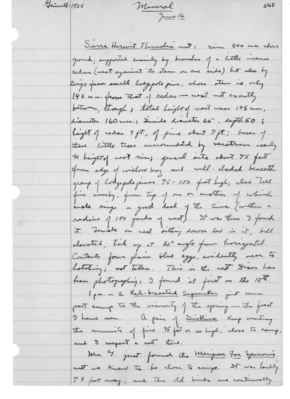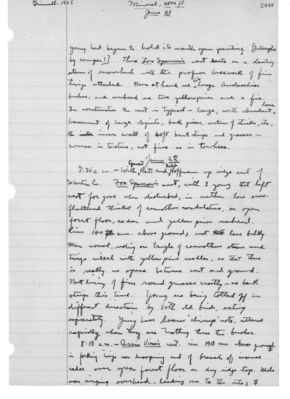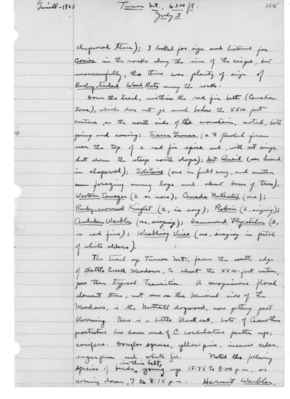Pages That Mention incense cedar
1925: Joseph Grinnell's field notes
S2 Page 12
Collector: Grinnell - 1925 Location: Lassen Section (Mineral) Date: June 16, 1925 Page Number: 2468
Sierra Hermit Thrushes nest: rim 800 mm above ground; supported mainly by branches of a little incense cedar (nest against its stem on one side) but also by twigs from small lodgepole pine, whose stem is only 145 mm. from that of cedar - nest not exactly between, though; total height of nest was 145 mm., diameter 160 mm.; divide diameter 65, depth 50; height of cedar 4 ft., of pine about 7 ft.; bases of these little trees surrounded by veratrum nearly to height of nest rim; general site about 75 fee from edge of willow bog and well-shaded beneath group of lodgepole pines 75-100 feet high; also tall firs nearby, from tip of one or another of which male sings a good deal of the time (within a radius of 100 yards of nest). It was thus I found it. Female on nest sitting down low in it, bill elevated, tail up at 80° angle from horizontal. Contents four plain blue eggs, evidently near to hatching; not taken. This is the nest Dixon has been photographing; I found it first on the 13th. 1 p.m. - a Red-breasted Sapsucker just came past camp to the vicinity of the spring - the first I have seen. A pair of Siskins keep visiting the summit of firs 75 feet or so high, close to camp, and I suspect a nest there. Mrs. G just found the Mariposa Fox Sparrow's nest we knew to be close to camp. It was hardly 75 feet away, and the old birds are continually
S2 Page 33
Collector: Grinnell-1925 Location: Mineral, 4800 ft. Date: June 21 Page Number: 2488
young had begun to hold its mouth open pouting. [Interrupted by camper!] This Fox Sparrow's nest rests on a slanting stem of snow-bush with the proper lacework of fine twigs attached. Near at hand are two large Amelanchier bushes; and overhead are two yellow pines and a fir. In construction the nest is typical - large, with abundant loose basement of large objects, bark pieces, section of sticks, etc., the inner wall of soft bark strips and grasses course in texture, not fine as in towhees.
June 22 7:34 a.m. - With ^Egmont Rett and ^Ralph Hoffmann up ridge east of Martin Cr. Fox Sparrow's nest, with 3 young that left nest for good when disturbed, in rather low snow flattened thicket of ceanothus cordulatus, on open forest floor, cedar and yellow pines overhead. Rim 140 ft mm. above ground; nest last less bulky than usual, resting on tangle of ceanothus stems and twigs mixed with yellow pine needles, so that there is really no open space between nest and ground. Nest lining of fine round grasses mostly - no bark strips this time. Young are being lolled (?) off in different direction by both old birds, acting separately. Young have hoarse "chirrup" note, uttered rapidly when they are trotting thru the bushes.
8:15 a.m. - Cassin Vireo's nest: rim 1910 mm. above ground in forking twigs near drooping end of branch of incense cedar over open forest floor on dry ridge top. Male was singing overhead, leading me to the site; [female symbol]
S2 Page 52
Collector: Grinnell - 1925 Location: Mineral Date: June 28 Page Number: 2506
per acre. The tract in question is gently sloping toward the south; while there is no water on it, water is within easy reach, at the camp ground spring 100 yards to the east or at the first willow bog 200 yards to the south. The vegetation is mixed conifer and chaparral, the later by area predominating and consisting almost solely of ceanothus cordulatus, so greatly like by many birds because it affords safe nesting places plus (right now) an abundance of insect life. The conifers on it are chiefly firs (white), but there are also lone yellow pines, affording lofty perches, and some incense cedars.
We have seen many other birds on our plot, besides those named on the map - foragers or vagrants from adjacent ground; for example, Calif. Purple Finches, Siskins, and Evening Grosbeaks; and at night, Pacific Nighthawks. One puzzling case is that of Calliope Hummers, of which 4 males have separate distinct "stands" on our plot. The females come onto the plot to forage about the castillejas plentiful in the brush, but as far as we can judge, these females are only visitors, having there [sic] nests off somewhere, probably in the belt of lodge pole pines down along the willow-bogs, where the males do not go. One male has his "stand" one telefone [sic] wire, which crosses our plot near its southern boundary. Beneath
S2 Page 65
Collector: Grinnell - 1925 Location: Turner Mt., 6300 ft. Date: July 3 Page Number: 2518
chaparral there); I looked for sign and listened for Conies in the rocks along the rim of the cirque, but unsuccessfully, tho there was plenty of sign of Bushy-Tailed Wood Rats among the rocks.
Down the trail, within the red fir belt (Canadian Zone), which does not go much below the 5500 foot contour, on the north side of the mountain, noted, both going and coming: Sierra Grouse (a [male symbol] flushed from near the top of a red fir spire and, with set wings, shot down the steep north slope); Mt. Quail (one heard in chaparral); Solitaire (one in full song, and another seen foraging among logs and about bases of trees); Western Tanager (2 or more); Canada Nuthatch (one); Ruby-crowned Kinglet (2, in song); Robin (2, singing); Audubon Warbler (one, singing); Hammond Flycatcher (2, in red firs); Warbling Vireo (one, singing in patch of white alders).
The trail up Turner Mt. from the south edge of Battle Creek Meadows, to about the 5500-foot contour, goes thru [sic] typical transition. A conspicuous floral element there, not seen on the Mineral side of the Meadows, is the Nuttall dogwood, now getting past blooming. There is a little black oak, lots of Ceanothus prostratus low down and of C. cordulatus farther up; conifers: Douglas spruce, yellow pine, incense cedar, sugar pine, and white fir. Noted the following species of birds ^in this belt, going up 12:45 to 3:00 p.m., or coming down, 7 to 8:15 p.m.: Hermit Warbler,
S2 Page 84
Collector: Grinnell - 1925 Location: Mineral Date: July 29 Page Number: 2535
We were seated on a log, when a Eutamias senex ran across some open round within 40 feet of us and disappeared into another large log; in the animal's mouth was a baby chipmunk, about 1/4 grown it looked, belly up and tail curled over the mother's head. As I was walking along the trail, I saw some small animal scurry along the side of a rotten log and across the open for 2 feet disappearing under a slab of rotten wood. I lifted up the latter, expecting a lizard (tho [sic] no lizard has been seen up Viola Trail), when out popped a Shrew (see beyond) which Mrs. G. pounced upon with success. Here was a case of a shrew venturing out into the open close to noon of a brilliantly sunshiny day; it was a suckling [female symbol]. The rotten wood and earth beneath the log and slab was quite damp. No nest was discovered.
6295 Sorex m. mariposa (?) [female symbol] suckling 6.8g. 120x51x14.5x4. Caught under slab (as above) on ground in Transition zone (Dry woods of yellow pine, white fir and incense cedar) on ridge at 550 ft., 2 mi. NE Mineral.
6296 Sorex v. amoenus (?) [male symbol] 4.7g 108x44x11.5x3. Caught in oat-baited mouse trap (scented) set in rank grass under willows in bog near camp.
6297 Thomomys monticola [male symbol] 92g. 205x66x26x8.
6298 [Thomomys] [monticola] [male symbol] ju. 51g. 170x55x25x7.
Both these gophers caught near camp, in traps, in dryish ground between ceanothus thickets.




